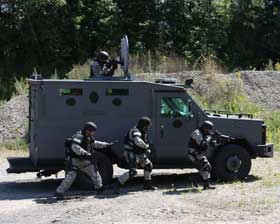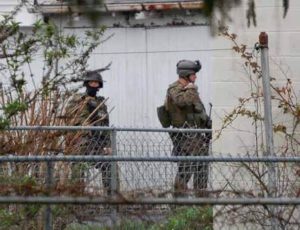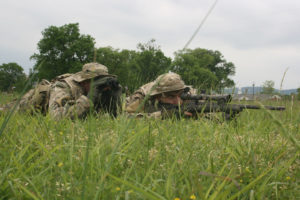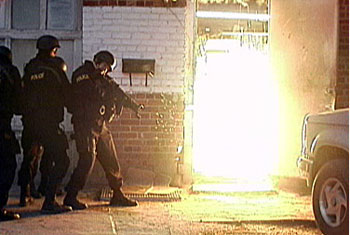Written by: Greg Ellifritz
Last week, a Houston resident foiled a home invasion attempt by a couple criminals trying to impersonate DEA agents. Take a look at the photo below. If they were beating on your door, would you open up or open fire? The resident here made the correct choice and called the (real) police. The criminals took off.
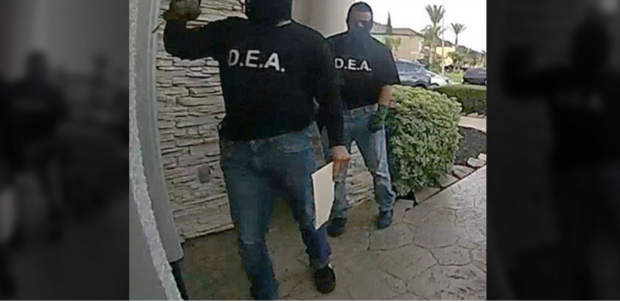
How can you tell the difference between a police raid and a home invasion?
This is a very legitimate concern. Home invading criminals regularly use ruses such as this to gain access to your house. They will show up wearing raid jackets (which can be easily bought online), kick in your door, and hold you at gunpoint as they steal all your stuff. If you doubt that this occurs, do a quick internet search on the terms “fake SWAT raid robbery”. You’ll find dozens of news stories reporting similar tactics.
The legally armed homeowner is placed in a serious predicament here. He doesn’t want to get in a shootout with a legitimate SWAT team (which could be raiding the wrong house by mistake. It’s really bad, but it does happen) nor does he want to instantly surrender and be at the mercy of a bunch of thugs who bought some “police” jackets on eBay. What can he do?
Before I get into some specific recommendations, a little general education about warrants and warrant service is in order….
With a few exceptions (fresh pursuit, consent, imminent destruction of evidence, a threat to public safety) police need a warrant to enter your house. When they go to the judge to detail the probable cause for getting the warrant, they must specify whether the warrant is to be a “knock and announce” warrant or a “no knock” warrant.
No knock warrants are reserved for serious crimes where officers have reason to believe that evidence will be destroyed or they will be in danger if they take the time to knock. On a “knock and announce” warrant, police must give “reasonable” time for you to answer the door before kicking it in. What constitutes “reasonable” depends on the circumstances and the court jurisdiction.
Additionally, the warrant must specify if it is to be served during daylight hours or at night. Courts recognize that nighttime warrant service is much more dangerous to both officers and homeowners, so most warrants have specifications that they only be served in daylight hours.
These two pieces of knowledge will be your first indicators of potential criminal activity. Most warrants are served in the day time with knock and announce requirements. Most home invasions occur at night without any formal announcement before kicking in the door. That doesn’t mean that you should automatically shoot if you hear someone yelling “police” as they kick in your door at night. The cops could have been issued a “no knock” nighttime warrant; it just isn’t quite as common. Statistically, you are more likely to be facing home invaders than cops if your door is kicked in in the middle of the night.
Here are a few more differences between most police raids and most home invasions:
Presence of uniformed officers and marked cars. In almost all police raids, there will be traditionally uniformed officers and marked police cars to supplement the SWAT guys. Look for them. If you see a cruiser parked outside your house, it’s most likely the police.
Sometimes, the marked cruisers will pull up just after the SWAT team gets there to ensure the occupants aren’t spooked before the SWAT team makes entry. The lack of a police car doesn’t automatically give you license to shoot.
If you don’t see police cars, look for specialized vehicles of some sort. Armored personnel carriers are used in some areas. Other teams use large cargo vans with blacked-out windows. You may also see an RV that is usually called a “mobile command post.” All of those vehicles would be indicative of a police raid.
The police aren’t likely to arrive in that 1992 Oldsmobile Cutlass that you may see backed into your driveway.
Perimeter control. Before SWAT will hit a house; they will ensure that all sides of the house and all exits are covered in order to catch anyone trying to escape. If you can’t see the front of the house, look out a back window. If you see a uniformed officer in your back yard covering your back door, it’s probably a police raid. Home invaders generally don’t cover the back of the house.
Smart officers on perimeter control duties will try as hard as possible to stay out of the view of the house. They will be using trees or cars as cover. If they are doing their jobs correctly, you won’t see them. Just like the point above, an absence of uniformed officers isn’t an automatic indicator that you are being robbed. But if you do see a uniformed officer, it would be safe to assume it is a SWAT raid.
Specialized Equipment. Many SWAT teams will use powerful, weapon mounted flashlights, both on their handguns and long guns. You may also see ballistic shields. I’ve never seen a home invasion where a criminal used a weapon mounted light or ballistic shield.
Badges- There are certainly fake badges available on the internet, but I’ve never seen home invaders using them. Even plain clothes cops will have badges prominently displayed, either pinned to their chest, hanging around their necks, or clipped to a belt. Many SWAT teams will actually pin metal badges on the chests of their raid gear, even if they have “POLICE” emblazoned on the front and back.
If you don’t see any badges, it isn’t a legitimate police raid.
Belts and Equipment- Take a look at the photo from this incident. Neither suspect is wearing a belt. That should be a big clue. Cops carry lots of stuff. Even the plainclothes guys on a raid will be carrying a gun, radio, spare mags, handcuffs, and a flashlight. Officers are most certainly wearing belts to hold all this gear. Even guys who wear load bearing vests or chest rigs will still be wearing a belt. It may not be a full police gun belt, but they will have something to hold auxiliary gear that the vest won’t carry.
Another piece of equipment to look for is a radio. All the cops on a raid will have a police radio (walkie-talkie). It may be on the vest or clipped on the belt. SWAT teams will likely have helmets with mounted radio headsets using mouth or throat microphones. I’ve never seen a reported home invasion where the criminals are using radios (even the commonly available walkie-talkies you can buy at a sporting goods store). No radios = No police.
Number of people. Most SWAT teams won’t hit a house unless they have clear numerical superiority over the occupants. That means at least six to twelve officers depending on the size of the house. Most home invasion teams number from two to four.
Rapid entry. If your door is entered exceptionally quickly, it’s likely a SWAT team. Most SWAT teams use battering rams, prying tools or explosives to make very rapid entries. Most home invaders kick the door. It generally takes longer to kick the door than ram it. If you are hearing lots of ineffective beating at the door, it’s likely home invaders.
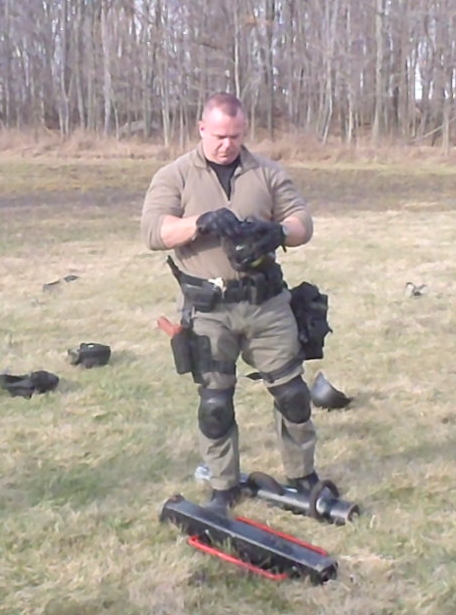
The author donning a gas mask before grabbing a door ram during a tactical breaching instructor class. These rams make doors open quickly!
Lots of verbalization. The police don’t want you to mistake them for criminals. That’s why, during a raid, ALL of the officers will be yelling “Police” to identify themselves. If you aren’t hearing lots of identifying words and verbal commands, you are likely dealing with home invaders.
Flash Bangs, Shields, and Break-and-Rake Tactics. On dangerous warrants, most SWAT teams initiate their entries by throwing flash bangs (small explosive devices that create a loud noise and bright flash). They may also break out your windows using tools or impact munitions on sides opposite the entry. Both of these tactics are designed to produce a stunning effect or distraction that will allow officers to get into the house and take control before you have time to act.
I’ve never seen a home invasion that uses flash bangs. Flash Bangs are classified by the ATF as destructive devices and civilians cannot purchase them. Even the police have to have special ATF authorization to buy them.
SWAT officers will likely also have at least one ballistic shield present in the “stack” when making entry. If you are seeing shields and hearing explosions, it’s a good bet that you are getting hit by a SWAT team, not a gang of criminals.
Those are the primary differences between a police raid and a home invasion. In order for you to utilize this information, you need TIME…time to look, time to wake up, time to analyze, time to call the police and verify if necessary.
To buy yourself time, you need to harden your house. Make sure you have good locks that are firmly screwed into wall studs with 3” screws. Lock your screen door or storm door. Put a solid core door with a deadbolt in your bedroom as well. All of those interventions will slow down both the police and home invaders, giving you more time to make a better assessment about what is really going on. If there is any doubt, make sure you call 911 immediately.
One other crucial piece of information that should be obvious, but can’t be overstated is this:
Criminal home invaders generally target drug dealers and drug users. I don’t have any formal statistics, but I would guess that about 90% of home invasions are drug dealers ripping off other drug dealers. Drug dealers and users generally have money and drugs. They are also hesitant to report crimes to the police. Both factors make them good victims.
Interestingly enough, most SWAT raids are prompted by drug sales as well. If you want to avoid both the home invasion and the SWAT raid, don’t use or sell drugs in your house. That may be the single most successful action you can take.
Even in the best of situations, this is still going to be a difficult scenario for an armed homeowner to handle properly. No matter what you do, you won’t likely have a whole lot of time to make a decision that will have life-altering implications. Harden your house, look for the indicators above, and stay out of trouble. It’s the best advice I can provide.
If you don’t want to miss any more articles like this, sign up for my email updates.

